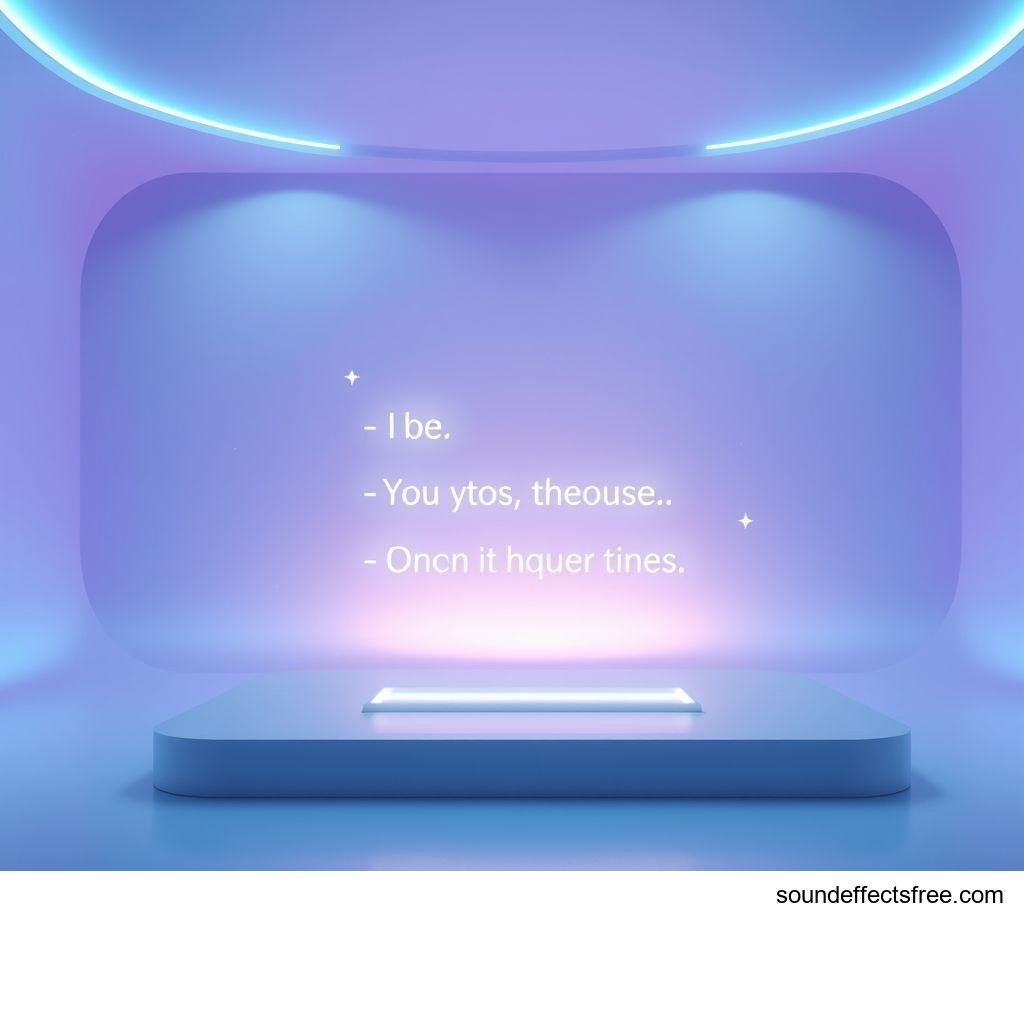Subtle Collapse: Elevating UI with Gentle Sound Feedback
The subtle collapse of a UI element can dramatically improve user experience. Think about how digital interfaces behave. Elements might expand or retract. They might appear and then then disappear. A well-designed audio cue enhances this interaction. It provides immediate feedback. This subtle sound guides the user. It makes the UI feel more responsive. Understanding these nuanced sounds is key.
Applications in Media
Subtle sounds are vital across many media types. They provide cues without being intrusive. A soft collapse sound can mark a transition. It might signal a menu closing. Or it could be an item retracting. This sound confirms an action. It lets the user know something has completed. This gentle audio feedback makes the UI feel more responsive. The interface seems more alive. It's about enhancing the overall user journey.
Industry-Specific Uses
In gaming, a subtle collapse might indicate an inventory slot emptying. Or perhaps a power-up expiring. For business software, it could signify a tab closing. It might be a notification panel retracting. E-commerce sites use these sounds too. A gentle audio effect can confirm an item removed from a cart. It helps the user understand the system's state. The sound helps elements settle into their new position. It provides a sense of finality. This prevents user confusion.
Creative Techniques
Sound designers use specific techniques. They create the perfect collapse sound. This often involves very short durations. They use gentle decay curves. The sound needs to be present but not dominant. It should support the visual. It never overwhelms the user. Designers often layer different elements. This creates a richer, yet still subtle, sound. A soft "whoosh" might combine with a small "click." This layered approach defines the character of the collapse. It makes the UI feel intuitive.
Technical Analysis
Understanding the technical aspects is crucial. It helps in crafting effective UI sounds. A collapse sound is often brief. Its technical profile is specific. It aims for clarity and brevity. The goal is to convey meaning instantly. Without causing distraction. This requires precise sound design.
Waveform Characteristics
The waveform of a good collapse sound is typically short. It often has a quick attack. Then a rapid decay. This brief envelope creates a sense of quick closure. There should be no lingering tail. A clean cutoff is important. This ensures the sound does not muddle with subsequent actions. It helps elements visually collapse without audio clutter. The waveform usually shows a sharp initial transient. Followed by a quick fade out. This characteristic helps the sound settle quickly.
Frequency Profile
A collapse sound usually occupies a specific frequency range. It often has mid-to-high frequencies. These frequencies cut through other sounds. They provide clear, crisp feedback. Very low frequencies can sound boomy. They might feel too heavy for a subtle interface sound. High frequencies add a sense of air or quickness. They help define the delicate nature of the collapse. Balancing these frequencies ensures the sound is noticeable. But it remains unobtrusive. It complements the visual action.
Production Tips
Creating effective interface sounds requires care. Especially for a subtle collapse effect. The production process involves precise steps. Quality is paramount for user satisfaction.
Recording & Editing
Start with clean source recordings. Use high-quality microphones. Record various real-world sounds. Think about gentle closing sounds. Maybe the soft click of a button. Or a rustle of fabric. Edit these sounds meticulously. Remove any unwanted noise. Focus on the transient portion. That first quick impulse is key. Then shape the decay. Make sure it tapers off quickly. This creates a distinct audio effect. It helps the sound retract effectively. Ensure the sound feels natural when it makes an element collapse.
Software Tools
Digital Audio Workstations (DAWs) are essential. Programs like Ableton Live or Logic Pro are common. Use precise editing tools within these DAWs. Apply gentle compression. This controls dynamics. Use subtle EQ adjustments. Shape the frequency profile. Add a touch of short reverb. This gives the sound some space. But avoid long, washed-out effects. The goal is a clean, quick collapse. Many VST plugins also offer unique shaping capabilities. They can help refine the subtle audio effect.
Creative Implementation
Beyond basic application, creativity elevates interface sounds. How you implement a collapse sound matters. It influences user perception deeply. Thoughtful use enhances the overall UX.
Layering Methods
Layering is a powerful technique. Combine different sound samples. A soft click can layer with a gentle whoosh. This creates a richer, more complex collapse. Yet it remains subtle. Ensure phases are aligned. This avoids unwanted phase cancellation. Adjust individual levels carefully. The goal is a cohesive sound. One that enhances the visual collapse. It shouldn't sound like multiple distinct sounds. It should feel like one unified audio event. This can make a simple action feel more refined.
Spatial Effects
Consider using subtle panning. If an element collapses from left to right. The sound can follow that motion. A slight stereo spread can add depth. This creates a more immersive experience. It can make the interface feel more tangible. Spatial effects should be minimal. They should support the visual. They should not draw attention away from it. The goal is to subtly guide the user's ear. It helps the ear follow the visual collapse.
Sound Pack Integration
A good collapse sound often comes from a curated pack. These packs offer consistency. They ensure all sounds work well together.
Using with Other Sounds
The "Subtle Collapse" sound fits well with other UI elements. Use it with click sounds. Pair it with confirmation beeps. Ensure volume levels are balanced. The collapse should complement other interface sounds. It should never overpower them. Consistency in sound design is key. This maintains a coherent user experience. It helps elements to retract smoothly. Related collapse sounds can provide more options. Consider how this sound affects overall user feedback. A harmonious soundscape leads to better UX.
Complete Collection
Expanding your sound library is always beneficial. A full sound pack offers diverse options. It gives you more creative freedom. Explore various audio effects. Find the perfect sounds for every interaction. Get the full sound pack for comprehensive audio solutions. This ensures you have every collapse and retract sound you need. UI Confirm Tap is another great example of subtle feedback.

The subtle collapse sound is more than just an audio effect. It is a vital component of good user experience. It provides intuitive feedback. It makes digital interactions feel natural. Mastering its application enhances any product. Consider its gentle power. Use it to elevate your designs. This small detail can make a huge difference.
FAQ about Subtle Collapse Sounds
Q: What is a "subtle collapse" sound effect? A: It's a brief, soft audio effect. It indicates that a digital element is retracting or closing. Think of a menu folding down. Or a panel closing. It provides gentle feedback to the user.
Q: Why is subtle audio feedback important in UI design? A: Subtle audio feedback enhances user experience. It confirms actions. It makes interfaces feel more responsive. It helps elements visually collapse and settle effectively. This reduces user uncertainty.
Q: Can I use "collapse" sounds in video games? A: Absolutely. A subtle collapse sound can indicate many things. It might be an inventory slot closing. Or a notification disappearing. It provides crucial feedback to the player.
Q: How do you make a "collapse" sound subtle? A: Keep it short. Use a quick decay. Focus on mid to high frequencies. Layering soft sounds works well. The goal is clear, brief audio feedback. It should help an element truly collapse without being noisy.
Q: Where can I find high-quality "collapse" sound samples? A: Look for professional sound packs. Many audio libraries offer dedicated UI sound effects. Check reputable sites like Pro Sound Effects for a wide selection. These packs often contain excellent subtle sounds.





